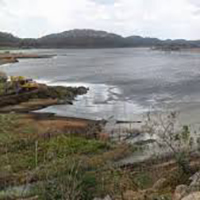Spatio-temporal variation of cyanobacteria and cyanotoxins in public supply reservoirs of the semi-arid region of Brazil
Cyanobacteria and cyanotoxins in reservoirs of the semi-arid region

Accepted: 16 September 2019
HTML: 151
All claims expressed in this article are solely those of the authors and do not necessarily represent those of their affiliated organizations, or those of the publisher, the editors and the reviewers. Any product that may be evaluated in this article or claim that may be made by its manufacturer is not guaranteed or endorsed by the publisher.
Authors
Cyanobacteria harmful algal blooms (CyanoHABs) have become increasingly frequent and intense in public supply reservoirs as a result of eutrophication and global climate change. The semi-arid region of Brazil has a well documented history of CyanoHABs but the underlying factors that control the excessive proliferation of these organisms and the production of their bioactive secondary metabolites are not comprehensively understood. This study aimed to identify the environmental factors that explain the spatial and temporal variations in the abundance of cyanobacteria and the concentration of cyanotoxins (microcystins, saxitoxins, and cylindrospermopsin) in semi-arid reservoirs. The following hypotheses were tested: (a) the largest biovolumes of potential toxin producing cyanobacteria occur when cyanotoxin concentrations are highest; and (b) the environmental factors that explain variations in biovolume of cyanobacteria also explain changes in cyanotoxins concentrations. Samples were taken from four reservoirs located in the Northeast region of Brazil, over a three-month period (October 2016 and February and June 2017). Of the 24 species of cyanobacteria identified, 13 were potentially toxin-producing. Physicochemical variables such as water volume of the reservoir, water transparency, soluble reactive phosphorus, and total phosphorus explained the abundance of cyanobacteria and the levels of cyanotoxins. These results corroborate the hypothesis that similar physicochemical conditions influence the abundance and diversity of cyanobacteria and cyanotoxins. Cyanobacterial blooms composed of more than one potential toxin producing species were observed in the studied reservoirs, where potential microcystin-producing species were the most common. Microcystins and saxitoxins were detected in all the reservoirs studied, while cylindrospermopsin and the cyanobacterium Cylindrospermopsis raciborskii were simultaneously recorded in only one reservoir (Camalaú Reservoir). Cylindrospermopsin was only detected in a reservoir for the first time in the State of Paraíba. Canonical redundancy analysis showed that the cyanotoxins were related to potential toxin producing species. These results corroborate the proposed hypothesis that there is a correlation between cyanotoxins and the biomass of potential producers. Also, there were situations where cyanotoxins were detected without the presence of potential producers. These results demonstrate the need for reassessment of potential toxin producing species of cyanobacteria in semi-arid reservoirs. This may lead to the identification and characterization of novel producers of these bioactive secondary metabolites.
Edited by
Andrea Lami, CNR-IRSA Verbania, ItalyHow to Cite
Similar Articles
- Rocio Fernandez, Sarma Nandini, S.S.S. Nandini, Maria E. Castellanos-Páez, Demographic responses of Heterocypris incongruens (Ostracoda) related to stress factors of competition, predation and food , Journal of Limnology: Vol. 75 No. s1 (2016): Proceedings of the 6th National Congress of Limnology
- Baoli WANG, Cong-Qiang LIU, Fushun WANG, Yuanxiu YU, Yanyou WU, Flow cytometric observation of picophytoplankton community structure in the cascade reservoirs along the Wujiang River, SW China , Journal of Limnology: Vol. 68 No. 1 (2009)
- Mattia M. Azzella, Italian Volcanic lakes: a diversity hotspot and refuge for European charophytes , Journal of Limnology: Vol. 73 No. 3 (2014)
- Anna Cichy, Maria Urbańska, Anna Marszewska, Wojciech Andrzejewski, Elżbieta Żbikowska, The invasive Chinese pond mussel Sinanodonta woodiana (Lea, 1834) as a host for native symbionts in European waters , Journal of Limnology: Vol. 75 No. 2 (2016)
- Luciana Avigliano, Alicia Vinocour, Griselda Chaparro, Guillermo Tell, Luz Allende, Influence of re-flooding on phytoplankton assemblages in a temperate wetland following prolonged drought , Journal of Limnology: Vol. 73 No. 2 (2014)
- Flávio H. Ragonha, Alice M. Takeda, Does richness of Oligochaeta (Annelida) follows a linear distribution with habitat structural heterogeneity in aquatic sediments? , Journal of Limnology: Vol. 73 No. 1 (2014)
- Jong-Yun Choi, Kwang-Seuk Jeong, Geung-Hwan La, Kwang-Hyeon Chang, Gea-Jae Joo, The influence of aquatic macrophytes on distribution and feeding habit of two Asplanchna species (A. priodonta and A. herrickii) in shallow wetlands, South Korea , Journal of Limnology: Vol. 74 No. 1 (2015)
- Päivi Rinta, David Bastviken, Jos Schilder, Maarten van Hardenbroek, Tabea Stötter, Oliver Heiri, Higher late summer methane emission from central than northern European lakes , Journal of Limnology: Vol. 76 No. 1 (2017)
- Andrew J. Tanentzap, Erik J. Szkokan-Emilson, Cyndy M. Desjardins, Chloe Orland, Kurt Yakimovich, Randy Dirszowsky, Nadia Mykytczuk, Nathan Basiliko, John Gunn, Bridging between litterbags and whole-ecosystem experiments: a new approach for studying lake sediments , Journal of Limnology: Vol. 76 No. 2 (2017)
- Jean-Michel Jaquet, Pascale Nirel, Agathe Martignier, Preliminary investigations on picoplankton-related precipitation of alkaline-earth metal carbonates in meso-oligotrophic lake Geneva (Switzerland) , Journal of Limnology: Vol. 72 No. 3 (2013)
<< < 17 18 19 20 21 22 23 24 25 26 > >>
You may also start an advanced similarity search for this article.
-
Juliana dos Santos Severiano, Edlayne Rayanara Pontes de Lima, Daniely de Lucena-Silva, Dayrla Kelly Gomes Rocha, Maria Eduarda Santana Veríssimo, Bruno Renaly Souza Figueiredo, José Etham de Lucena Barbosa, Joseline MolozziWater Research : 2023
-
Thiago Santos de Almeida Lopes, Amanda Myrna de Meneses e Costa, Whelton Brito dos Santos, Weruska Brasileiro Ferreira, Patricia Herminio CunhaCadernos Técnicos Engenharia Sanitária e Ambiental : 2023
-
Ranielle Daiana dos Santos-Silva, Juliana dos Santos Severiano, Mathias Ahii Chia, Tatiane Medeiros Queiroz, Micheline Kézia Cordeiro-Araújo, José Etham de Lucena BarbosaEnvironmental Pollution : 2024
-
Flávia Morgana Monteiro, Gustavo Correia de Moura, Juliana dos Santos Severiano, Camila Ferreira Mendes, José Etham de Lucena BarbosaAquatic Ecology : 2021
-
Andreia Souza Regis, Ronaldo Faustino da Silva , Fabio Henrique Portella Corrêa de Oliveira, Eduardo José Alécio de OliveiraRevista de Gestão Social e Ambiental : 2024

 https://doi.org/10.4081/jlimnol.2019.1893
https://doi.org/10.4081/jlimnol.2019.1893





